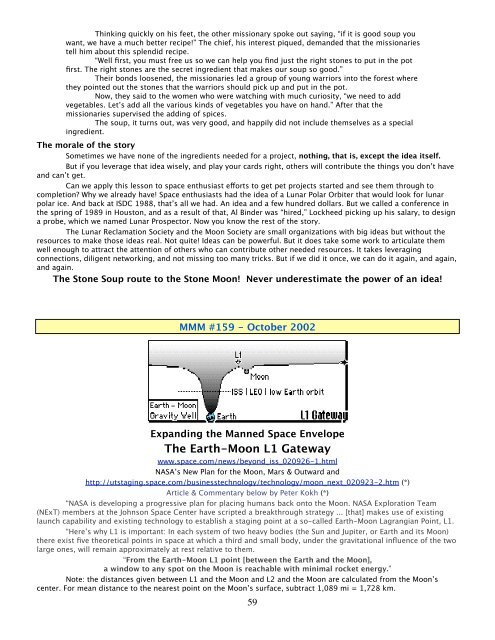Space Transportation - mmmt_transportation.pdf - Moon Society
Space Transportation - mmmt_transportation.pdf - Moon Society
Space Transportation - mmmt_transportation.pdf - Moon Society
Create successful ePaper yourself
Turn your PDF publications into a flip-book with our unique Google optimized e-Paper software.
Thinking quickly on his feet, the other missionary spoke out saying, “if it is good soup you<br />
want, we have a much better recipe!” The chief, his interest piqued, demanded that the missionaries<br />
tell him about this splendid recipe.<br />
“Well first, you must free us so we can help you find just the right stones to put in the pot<br />
first. The right stones are the secret ingredient that makes our soup so good.”<br />
Their bonds loosened, the missionaries led a group of young warriors into the forest where<br />
they pointed out the stones that the warriors should pick up and put in the pot.<br />
Now, they said to the women who were watching with much curiosity, “we need to add<br />
vegetables. Let’s add all the various kinds of vegetables you have on hand.” After that the<br />
missionaries supervised the adding of spices.<br />
The soup, it turns out, was very good, and happily did not include themselves as a special<br />
ingredient.<br />
The morale of the story<br />
Sometimes we have none of the ingredients needed for a project, nothing, that is, except the idea itself.<br />
But if you leverage that idea wisely, and play your cards right, others will contribute the things you don’t have<br />
and can’t get.<br />
Can we apply this lesson to space enthusiast efforts to get pet projects started and see them through to<br />
completion? Why we already have! <strong>Space</strong> enthusiasts had the idea of a Lunar Polar Orbiter that would look for lunar<br />
polar ice. And back at ISDC 1988, that’s all we had. An idea and a few hundred dollars. But we called a conference in<br />
the spring of 1989 in Houston, and as a result of that, Al Binder was “hired,” Lockheed picking up his salary, to design<br />
a probe, which we named Lunar Prospector. Now you know the rest of the story.<br />
The Lunar Reclamation <strong>Society</strong> and the <strong>Moon</strong> <strong>Society</strong> are small organizations with big ideas but without the<br />
resources to make those ideas real. Not quite! Ideas can be powerful. But it does take some work to articulate them<br />
well enough to attract the attention of others who can contribute other needed resources. It takes leveraging<br />
connections, diligent networking, and not missing too many tricks. But if we did it once, we can do it again, and again,<br />
and again.<br />
The Stone Soup route to the Stone <strong>Moon</strong>! Never underestimate the power of an idea!<br />
MMM #159 - October 2002<br />
Expanding the Manned <strong>Space</strong> Envelope<br />
The Earth-<strong>Moon</strong> L1 Gateway<br />
www.space.com/news/beyond_iss_020926-1.html<br />
NASA’s New Plan for the <strong>Moon</strong>, Mars & Outward and<br />
http://utstaging.space.com/businesstechnology/technology/moon_next_020923-2.htm (*)<br />
Article & Commentary below by Peter Kokh (*)<br />
“NASA is developing a progressive plan for placing humans back onto the <strong>Moon</strong>. NASA Exploration Team<br />
(NExT) members at the Johnson <strong>Space</strong> Center have scripted a breakthrough strategy ... [that] makes use of existing<br />
launch capability and existing technology to establish a staging point at a so-called Earth-<strong>Moon</strong> Lagrangian Point, L1.<br />
“Here’s why L1 is important: In each system of two heavy bodies (the Sun and Jupiter, or Earth and its <strong>Moon</strong>)<br />
there exist five theoretical points in space at which a third and small body, under the gravitational influence of the two<br />
large ones, will remain approximately at rest relative to them.<br />
“From the Earth-<strong>Moon</strong> L1 point [between the Earth and the <strong>Moon</strong>],<br />
a window to any spot on the <strong>Moon</strong> is reachable with minimal rocket energy.”<br />
Note: the distances given between L1 and the <strong>Moon</strong> and L2 and the <strong>Moon</strong> are calculated from the <strong>Moon</strong>’s<br />
center. For mean distance to the nearest point on the <strong>Moon</strong>’s surface, subtract 1,089 mi = 1,728 km.<br />
59















